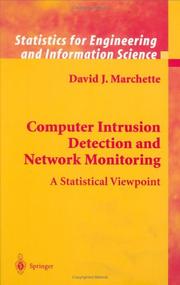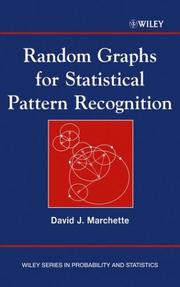| Listing 1 - 5 of 5 |
Sort by
|

ISBN: 0387952810 1441929371 1475734581 9780387952819 Year: 2001 Publisher: New York Springer
Abstract | Keywords | Export | Availability | Bookmark
 Loading...
Loading...Choose an application
- Reference Manager
- EndNote
- RefWorks (Direct export to RefWorks)
In the fall of 1999, I was asked to teach a course on computer intrusion detection for the Department of Mathematical Sciences of The Johns Hopkins University. That course was the genesis of this book. I had been working in the field for several years at the Naval Surface Warfare Center, in Dahlgren, Virginia, under the auspices of the SHADOW program, with some funding by the Office of Naval Research. In designing the class, I was concerned both with giving an overview of the basic problems in computer security, and with providing information that was of interest to a department of mathematicians. Thus, the focus of the course was to be more on methods for modeling and detecting intrusions rather than one on how to secure one's computer against intrusions. The first task was to find a book from which to teach. I was familiar with several books on the subject, but they were all at either a high level, focusing more on the political and policy aspects of the problem, or were written for security analysts, with little to interest a mathematician. I wanted to cover material that would appeal to the faculty members of the department, some of whom ended up sitting in on the course, as well as providing some interesting problems for students. None of the books on the market at the time had an adequate discussion of mathematical issues related to intrusion detection.
Mathematical statistics --- Computer security --- Computer networks --- Statistical methods. --- Security measures --- Statistical methods --- Monitoring --- Statistics . --- Probabilities. --- Data encryption (Computer science). --- Computer communication systems. --- Information storage and retrieval. --- Pattern recognition. --- Statistics for Engineering, Physics, Computer Science, Chemistry and Earth Sciences. --- Probability Theory and Stochastic Processes. --- Cryptology. --- Computer Communication Networks. --- Information Storage and Retrieval. --- Pattern Recognition. --- Design perception --- Pattern recognition --- Form perception --- Perception --- Figure-ground perception --- Communication systems, Computer --- Computer communication systems --- Data networks, Computer --- ECNs (Electronic communication networks) --- Electronic communication networks --- Networks, Computer --- Teleprocessing networks --- Data transmission systems --- Digital communications --- Electronic systems --- Information networks --- Telecommunication --- Cyberinfrastructure --- Electronic data processing --- Network computers --- Data encoding (Computer science) --- Encryption of data (Computer science) --- Cryptography --- Probability --- Statistical inference --- Combinations --- Mathematics --- Chance --- Least squares --- Risk --- Statistical analysis --- Statistical data --- Statistical science --- Econometrics --- Distributed processing --- Computer security - Statistical methods --- Computer networks - Security measures - Statistical methods --- Computer networks - Monitoring

ISBN: 0471221767 Year: 2004 Publisher: Hoboken, N.J. Wiley-Interscience
Abstract | Keywords | Export | Availability | Bookmark
 Loading...
Loading...Choose an application
- Reference Manager
- EndNote
- RefWorks (Direct export to RefWorks)
Book
Year: 2023 Publisher: New York, NY : Association for Computing Machinery,
Abstract | Keywords | Export | Availability | Bookmark
 Loading...
Loading...Choose an application
- Reference Manager
- EndNote
- RefWorks (Direct export to RefWorks)
It is our great pleasure to welcome you to the 2023 ACM International Workshop on Security and Privacy Analytics - IWSPA 2023. This year's workshop is the ninth in the series and co-hosted with the Thirteenth ACM Annual Conference on Data and Applications Security and Privacy (CODASPY 2023). IWSPA addresses important research topics associated with the application of data analytics tools and techniques (including statistical, machine learning, data mining, and natural language processing) to challenges that arise with security and privacy preservation. IWSPA provides a forum for the interaction between researchers in these areas, identifying and pursuing new topics that arise in the intersection between the fields of Artificial Intelligence and Cybersecurity.
Book
ISBN: 1032401001 1000727890 1000727653 0429326815 Year: 2020 Publisher: Boca Raton, FL : CRC Press,
Abstract | Keywords | Export | Availability | Bookmark
 Loading...
Loading...Choose an application
- Reference Manager
- EndNote
- RefWorks (Direct export to RefWorks)
"This book organizes in one place the mathematics, probability, statistics and machine learning information that is required for a practitioner of cybersecurity analytics, as well as the basics of cybersecurity needed for a practitioner"--
Book
ISBN: 9780367346010 9780367346027 Year: 2020 Publisher: Boca Raton, FL : CRC Press,
Abstract | Keywords | Export | Availability | Bookmark
 Loading...
Loading...Choose an application
- Reference Manager
- EndNote
- RefWorks (Direct export to RefWorks)
"This book organizes in one place the mathematics, probability, statistics and machine learning information that is required for a practitioner of cybersecurity analytics, as well as the basics of cybersecurity needed for a practitioner" [Publisher]
Computer security. --- Cyber intelligence (Computer security) --- Systèmes informatiques --- Cyberdéfense --- Mesures de sûreté --- Examens
| Listing 1 - 5 of 5 |
Sort by
|

 Search
Search Feedback
Feedback About UniCat
About UniCat  Help
Help News
News